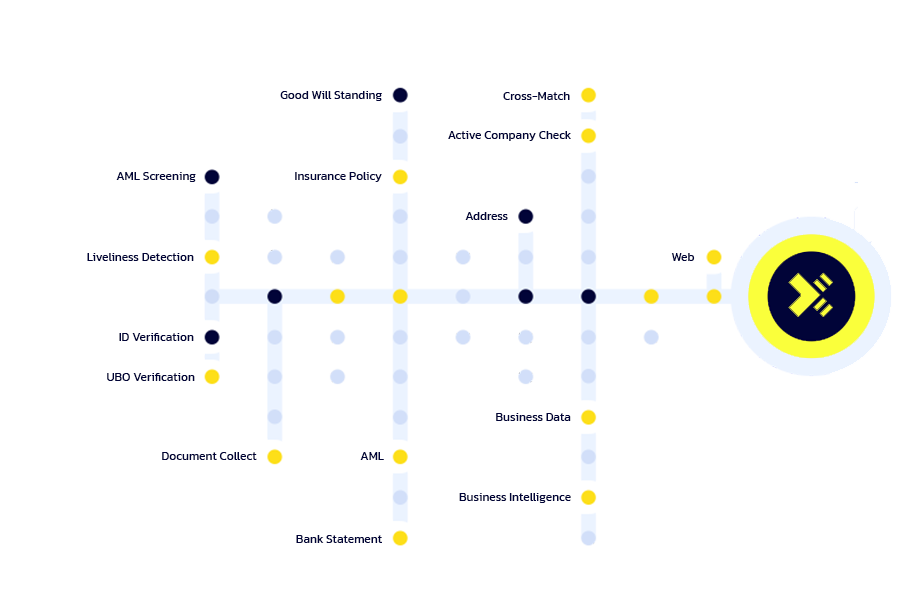How to build a seamless & compliant B2B onboarding (KYB) flow
Developing a successful B2B onboarding (KYB) process requires a nuanced approach that balances compliance obligations with customer satisfaction. We’ve compiled a set of guidelines to help you navigate this challenge effectively.
Introduction
A B2B onboarding flow is a vital tool for businesses to welcome new clients and facilitate their adoption of your product or service. It also enables you to meet your regulatory obligations and guard against fraudulent activities. A streamlined onboarding process can significantly impact the success of your business.
A well-designed B2B onboarding flow should offer an effortless sign-up experience for clients. While ensuring compliance and identity verification, it is crucial to simplify the registration and onboarding processes as much as possible. We understand that obtaining the necessary information to make an informed and compliant decision about new customers can be challenging. However, by optimizing the onboarding process, you can create a positive experience for your clients while safeguarding your business against potential fraud.

Use of third-party services
In order to streamline the onboarding process for your users, it is important to be mindful of the information that is collected. By limiting the amount of data collected to only the necessary information, you can reduce the burden on users. Additionally, using third-party services to verify information whenever possible can save time and effort for both you and your users.Determining which information is necessary for accurate verification can be a daunting task.
However, by collecting the legal name, contact information, name of the primary decision-maker, documentation of legal status, and financial information, you can confidently authenticate the business’s identity. To further reduce the burden on users, consider utilizing third-party sources to retrieve some of this information, such as the business’s articles of incorporation, business license, or tax identification number. By implementing these strategies, you can create a professional onboarding process that is efficient and effective for everyone involved.

An effective strategy to combat simple fraud is by adopting a cross-checking approach. Cross-checking involves requesting information from the user and verifying it against trusted and reliable sources of information. This process not only improves the accuracy of the information but also minimizes the incidence of fraudulent activities, thereby promoting the integrity of the organization. Therefore, it is highly recommended that organizations embrace cross-checking as a proactive measure to prevent fraudulent activities and safeguard their operations against potential risks.
It is important to be diligent in avoiding fraudulent activity and complying with relevant regulations in collecting customer information. Utilizing reputable third-party services to gather necessary data and requesting only essential information from customers can mitigate the risk of fraud. The level of information required may vary depending on factors such as the customer’s demographics and the specific product or service being offered. Taking a careful approach to collecting customer data is crucial in maintaining the trust and integrity of your business operations.
Create for an “attractive” & helpful UI/UX experience
To enhance the user experience on your website, it is recommended to utilize the various web tools available, including forms and drop boxes. It can be beneficial to include search bars to aid in prospect’s company search. Implementing autocomplete in search bars can elevate the overall experience and remove the need for the user to type the entire name of their company. Additionally, it is advised to use third-party data to autofill as many fields as possible once the user selects their company from the search bar. By utilizing these tips, you can create a state-of-the-art user experience that will enhance your website’s functionality and improve customer satisfaction.
It’s important to consider why certain user information fields are collected, even if data can be obtained from third-party sources. There may be instances where a prospect is not able to find their company through the search bar due to outdated data or if the company was recently incorporated.
In situations like these, it may be best to allow the user to complete all fields manually. It’s also crucial to ensure that autofilled fields such as the address use updated data from official company registers.
Providing users with the option to update their information gives them agency and ensures accurate data. While search bars and autofill features are useful suggestions, they should not limit the user’s ability to provide the most relevant and up-to-date information.

Divide the process into steps that are trackable
Understanding Know-Your-Business (KYB) information can be a complex process for users. One effective method to ease users’ experience and reduce cognitive overload is by breaking the flow into more manageable steps. This approach allows users to focus on one task at a time while reducing the perceived difficulty and frustration of completing the process.
It is also essential to provide feedback to users on their progress. A progress stepper can be incorporated to give users a clear indication of their level of completion throughout the onboarding process. Incorporating these strategies into your onboarding process can significantly enhance the user’s experience and increase the likelihood of successful completion.

Build unique onboarding journeys based on risk and jurisdiction
If your business operates across multiple geographies or sectors, it’s important to consider the format of the Know-Your-Business information you request from potential clients. Depending on the sector of the client or the country of incorporation, there may be specific requirements that need to be addressed.
To streamline the process for your clients, we suggest adding a step to your web onboarding flow that allows users to select their country. This will enable you to show country-specific information requests and present an appropriate route tailored to the needs of the user’s specific location. By incorporating this small addition to your onboarding process, you can ensure a more efficient and effective experience for your clients, regardless of which industry they are coming from or where they are based.
Summary
When requesting Know-Your-Business information, it’s crucial to keep in mind that it can seem intimidating to users. It’s important to maintain clarity and conciseness and offer guidance to help users understand the requested information.
Creating an enjoyable B2B onboarding experience can be a difficult balancing act, collecting enough information to verify businesses and individuals while minimizing friction. However, utilizing third-party services, providing just the right amount of user information, and dividing the process into specific steps can help companies effectively implement a B2B onboarding flow and building user trust.

Good job! Please give your positive feedback
How could we improve this post? Please Help us.
